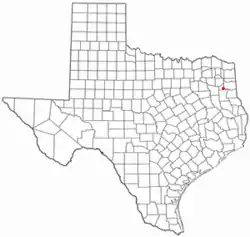Lakeport, Texas | |
|---|---|
 Location of Lakeport, Texas | |
 | |
| Coordinates: 32°24′34″N 94°42′32″W / 32.40944°N 94.70889°W | |
| Country | United States |
| State | Texas |
| County | Gregg |
| Area | |
| • Total | 1.59 sq mi (4.12 km2) |
| • Land | 1.59 sq mi (4.12 km2) |
| • Water | 0.00 sq mi (0.00 km2) |
| Elevation | 295 ft (90 m) |
| Population (2020) | |
| • Total | 976 |
| • Density | 610/sq mi (240/km2) |
| Time zone | UTC-6 (Central (CST)) |
| • Summer (DST) | UTC-5 (CDT) |
| ZIP code | 75603 |
| Area code | 903 |
| FIPS code | 48-40696[2] |
| GNIS feature ID | 1388566[3] |
| Website | City of Lakeport |
Lakeport is a city in Gregg County, Texas, United States. The population was 974 at the 2010 census,[4] up from 861 at the 2000 census; in 2020, its population was 976.[5]
Geography
Lakeport is located in southeastern Gregg County at 32°24′34″N 94°42′32″W / 32.40944°N 94.70889°W (32.409544, –94.709010).[6] Texas State Highway 149 (Estes Parkway) forms the northeastern border of the city, and leads north 7 miles (11 km) to Longview and southeast 13 miles (21 km) to Tatum. Texas State Highway 322 passes through the west side of Lakeport, starting at Highway 149 and leading south 20 miles (32 km) to Henderson. The city is bordered to the south by East Texas Regional Airport.
According to the United States Census Bureau, Lakeport has a total area of 1.6 square miles (4.1 km2), all land.[4] The Sabine River forms part of the northwestern border of the city.
Demographics
| Census | Pop. | Note | %± |
|---|---|---|---|
| 1970 | 411 | — | |
| 1980 | 835 | 103.2% | |
| 1990 | 710 | −15.0% | |
| 2000 | 861 | 21.3% | |
| 2010 | 974 | 13.1% | |
| 2020 | 976 | 0.2% | |
| U.S. Decennial Census[7] | |||
According to the census of 2000, there were 861 people, 352 households, and 255 families residing in the city.[2] The population density was 555.0 inhabitants per square mile (214.3/km2). There were 373 housing units at an average density of 240.5 per square mile (92.9/km2). The racial makeup of the city was 47.27% White, 47.97% African American, 0.58% Native American, 0.23% Asian, 3.37% from other races, and 0.58% from two or more races. Hispanic or Latino of any race were 5.57% of the population.
| Race | Number | Percentage |
|---|---|---|
| White (NH) | 227 | 23.26% |
| Black or African American (NH) | 491 | 50.31% |
| Native American or Alaska Native (NH) | 4 | 0.41% |
| Asian (NH) | 17 | 1.74% |
| Mixed/Multi-Racial (NH) | 27 | 2.77% |
| Hispanic or Latino | 210 | 21.52% |
| Total | 976 |
As of the 2020 United States census, there were 976 people, 410 households, and 326 families residing in the city.
In 2000, the median income for a household in the city was $33,125, and the median income for a family was $45,000. Males had a median income of $35,329 versus $22,250 for females. The per capita income for the city was $18,646. About 9.8% of families and 11.0% of the population were below the poverty line, including 8.9% of those under age 18 and 18.3% of those age 65 or over. In 2020, the median household income grew to $61,500 with a mean household income of $70,444.[11]
Transportation
The East Texas Regional Airport is adjacent to Lakeport at the city's southern boundary.
References
- ↑ "2019 U.S. Gazetteer Files". United States Census Bureau. Retrieved August 7, 2020.
- 1 2 "U.S. Census website". United States Census Bureau. Retrieved January 31, 2008.
- ↑ "US Board on Geographic Names". United States Geological Survey. October 25, 2007. Retrieved January 31, 2008.
- 1 2 "Geographic Identifiers: 2010 Demographic Profile Data (G001): Lakeport city, Texas". American Factfinder. U.S. Census Bureau. Retrieved March 23, 2017.
- ↑ "2020 Race and Population Totals". data.census.gov. Retrieved May 20, 2022.
- ↑ "US Gazetteer files: 2010, 2000, and 1990". United States Census Bureau. February 12, 2011. Retrieved April 23, 2011.
- ↑ "Census of Population and Housing". Census.gov. Retrieved June 4, 2015.
- ↑ "Explore Census Data". data.census.gov. Retrieved May 25, 2022.
- ↑ https://www.census.gov/
- ↑ "About the Hispanic Population and its Origin". www.census.gov. Retrieved May 18, 2022.
- ↑ "2020 Annual Income Estimates". data.census.gov. Retrieved May 20, 2022.
